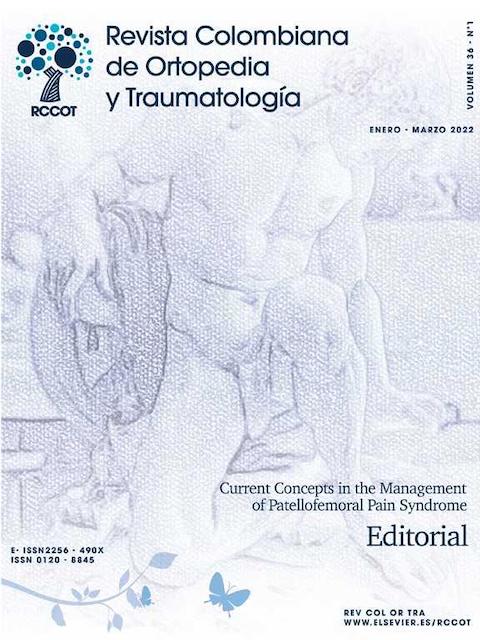Axial view of the shoulder. Description of a technique
DOI:
https://doi.org/10.1016/j.rccot.2022.04.001Keywords:
radiography, diagnostic imaging, shoulder injuries, shoulder dislocation, shoulder fracturesAbstract
Shoulder fracture is one of the most frequently treated injuries in trauma centers, with an overall incidence that appears to have increased in recent years, ranging from 219 to 419 cases per 100 000 person-years.
In clinical terms, shoulder girdle injury is difficult to diagnose due to the close relationship between the shoulder and the chest, and imaging identification of the different types of injuries can be challenging.
In this context, X-rays are the most appropriate method and the cornerstone of the initial approach to shoulder trauma, and at least 3 views are recommended: true anteroposterior view (AP), axial or axillary projection or modified axial projection (Velpeau view), and lateral scapula shoulder or Y view. However, patient positioning is often problematic due to the additional pain associated with limb mobilization in order to achieve the proper position for radiographic projection.
The following is the description of a technique for performing an axial shoulder projection that is free of these complications, easy to standardize, and applicable to any traumatic or degenerative disease of the proximal humerus or glenohumeral joint, which, to the best of the authors’ knowledge, has not been previously published.
Downloads
References
Beckmann NM, Sanhaji L, Chinapuvvula NR, West OC. Imaging of Traumatic Shoulder Girdle Injuries. Radiol Clin North Am. 2019;57:809-22, http://dx.doi.org/10.1016/j.rcl.2019.02.013.
Amini B, Beckmann NM, Beaman FD, Wessell DE, Bernard SA, Cassidy RC, et al. ACR Appropriateness Criteria ® Shoulder Pain-Traumatic. J Am Coll Radiol. 2018;15:S171-88.
Enger M, Skjaker SA, Melhuus K, Nordsletten L, Pripp AH, Moosmayer S, et al. Shoulder injuries from birth to old age: A 1-year prospective study of 3031 shoulder injuries in an urban population. Injury. 2018;49:1324-9, http://dx.doi.org/10.1016/j.injury.2018.05.013.
Nordqvist A, Petersson CJ. Incidence and causes of shoulder girdle injuries in an urban population. J Shoulder Elb Surg. 1995;4:107-12.
Sanders TG, Jersey SL. Conventional radiography of the shoulder. Semin Roentgenol. 2005;40:207-22.
Sanders TG, Morrison WB, Miller MD. Imaging Techniques for the Evaluation of Glenohumeral Instability. Am J Sports Med. 2000;28:414-34.
Rockwood and Matsen The Shoulder 4th Edition., Wirth MA, Lippitt S, Fehringer E V, Sperling JW, editors. Saunders; 2017.
Jordan H. New Technic for the Roentgen Examination of the Shoulder Joint. Radiology. 1935;25:480-4.
Bloom MH, Obata WG. Diagnosis of posterior dislocation of the shoulder with use of Velpeau axillary and angle-up roentgenographic views. J Bone Joint Surg Am. 1967;49:943-9.
Rubin SA, Gray RL, Green WR. The scapular ‘‘Y’’: a diagnostic aid in shoulder trauma. Radiology. 1974;110:725-6.
Sidor ML, Zuckerman JD, Lyon T, Koval K, Schoenberg N. Classification of proximal humerus fractures: The contribution of the scapular lateral and axillary radiographs. J Shoulder Elb Surg. 1994;3:24-7, http://dx.doi.org/10.1016/S1058-2746(09)80004-9.
Horsfield D, Jones SN. A Useful Projection in Radiography of the Shoulder. J Bone Joint Surg - Br Vol. 1987;69:338.
Monica J, Vredenburgh Z, Korsh J, Gatt C. Acute shoulder injuries in adults. Am Fam Physician. 2016;94:119-27.
Rothman RH. The Wheelchair Axillary View of the Shoulder. Orthopedics. 2007;30:265-6.
Ciullo JV, Koniuch MP, Tietge RA. Axillary shoulder roentgenography in clinical orthopaedic practice. Orthop Trans. 1982;6:451.
Clements RW. Adaptation of the technique for radiography of the glenohumeral joint in the lateral position. Radiol Technol. 1979;51:305-12.
Denis A, Vial J, Sans N, Loustau O, Chiavassa-Gandois H, Railhac JJ. Shoulder radiography: Useful radiographic views in current practice. J Radiol. 2008;89(5 C2):620-32, http://dx.doi.org/10.1016/S0221-0363(08)71494-X.





